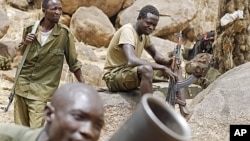In South Kordofan, the Sudanese Armed Forces and Sudan People’s Liberation Movement-North have been struggling for a year over control of the territory. But the clashes are taking their toll not only on the government army and rebels, but also on civilians.
Claudio Gramizzi, an independent researcher who writes reports for the Switzerland-based Small Arms Survey, has just returned from the region. He describes abandoned fields, where farmers have not been cultivating crops for fear of getting hit by aerial bomb attacks from the SAF. If the attacks continue, farmers will likely miss the planting season this year, too.
And as far as getting supplies from the single road to South Sudan, Gramizzi says an already difficult trip is about to become impossible.
“I actually had to travel from the border to Juba by car myself, and it took me three days,” he says. “There were already a lot of vehicles blocked in the mud, so the expectation is basically you have another couple of rains and the road will be blocked for at least three months.”
Ryan Boyette, an American who lives in South Kordofan and is married to a Nuba woman, confirms that people there are barely surviving. “Whether they’re in their homes or in caves, they’re all picking leaves of certain trees that they boil for hours and eat."
Boyette, who is sympathetic to the SPLM-N, and Gramizzi both say the Sudanese government has not allowed humanitarian aid organizations to bring food and other supplies into the region. Gramizzi says that is because Khartoum is trying to force civilians to move into government-controlled territory.
For instance, Gramizzi says that after a SAF attack in the village of Abu Hashim, people ran away and vacated the village. “Then when they came back two or three days later, they discovered a lot of things were looted. And that food stores were burned or destroyed.”
But the Sudanese Embassy in Washington, DC denies Khartoum is blocking aid. In an e-mail response to a request for an interview, an embassy spokesperson writes the challenge is getting aid to citizens without it falling into the hands of the rebels. And, he says, the government’s aggressive measures are aimed at restoring security to the area.
Ryan Boyette says those measures do not seem to be working to Khartoum’s benefit. “When Sudanese Armed Forces comes into a village and completely burns down houses or does aerial bombardments on villages, it enrages the people that are living here. And they end up joining the SPLM-North to fight against their government.”
Independent researcher Claudio Gramizzi says the SPLM-N appears to be controlling the region, and that morale is high.
Knowing what’s happening on the SAF side is harder, he says. But it appeared to him that even though Sudan had airplanes and helicopters, they did not have trained soldiers or new recruits.
Claudio Gramizzi, an independent researcher who writes reports for the Switzerland-based Small Arms Survey, has just returned from the region. He describes abandoned fields, where farmers have not been cultivating crops for fear of getting hit by aerial bomb attacks from the SAF. If the attacks continue, farmers will likely miss the planting season this year, too.
And as far as getting supplies from the single road to South Sudan, Gramizzi says an already difficult trip is about to become impossible.
“I actually had to travel from the border to Juba by car myself, and it took me three days,” he says. “There were already a lot of vehicles blocked in the mud, so the expectation is basically you have another couple of rains and the road will be blocked for at least three months.”
Ryan Boyette, an American who lives in South Kordofan and is married to a Nuba woman, confirms that people there are barely surviving. “Whether they’re in their homes or in caves, they’re all picking leaves of certain trees that they boil for hours and eat."
Boyette, who is sympathetic to the SPLM-N, and Gramizzi both say the Sudanese government has not allowed humanitarian aid organizations to bring food and other supplies into the region. Gramizzi says that is because Khartoum is trying to force civilians to move into government-controlled territory.
For instance, Gramizzi says that after a SAF attack in the village of Abu Hashim, people ran away and vacated the village. “Then when they came back two or three days later, they discovered a lot of things were looted. And that food stores were burned or destroyed.”
But the Sudanese Embassy in Washington, DC denies Khartoum is blocking aid. In an e-mail response to a request for an interview, an embassy spokesperson writes the challenge is getting aid to citizens without it falling into the hands of the rebels. And, he says, the government’s aggressive measures are aimed at restoring security to the area.
Ryan Boyette says those measures do not seem to be working to Khartoum’s benefit. “When Sudanese Armed Forces comes into a village and completely burns down houses or does aerial bombardments on villages, it enrages the people that are living here. And they end up joining the SPLM-North to fight against their government.”
Independent researcher Claudio Gramizzi says the SPLM-N appears to be controlling the region, and that morale is high.
Knowing what’s happening on the SAF side is harder, he says. But it appeared to him that even though Sudan had airplanes and helicopters, they did not have trained soldiers or new recruits.






